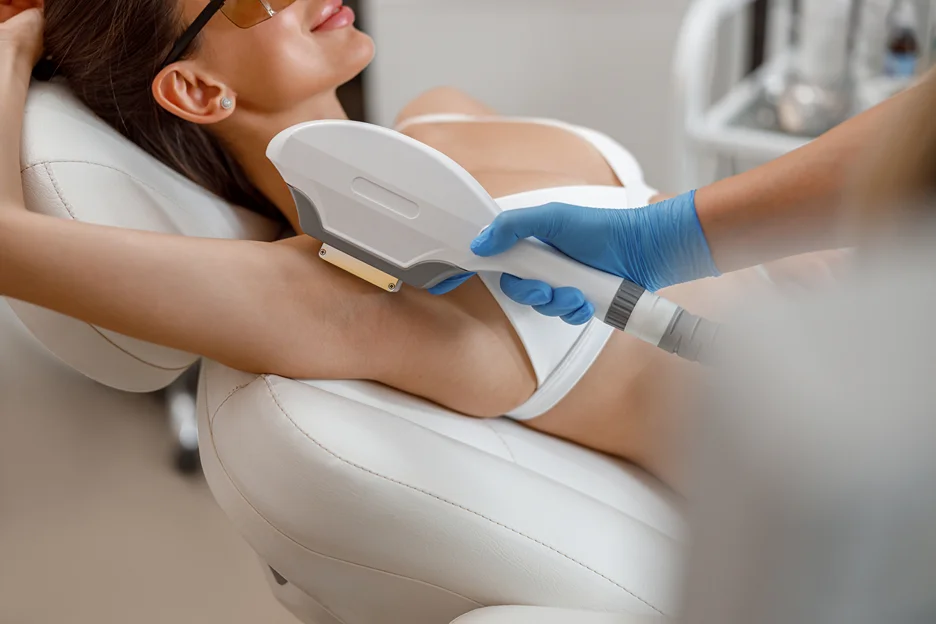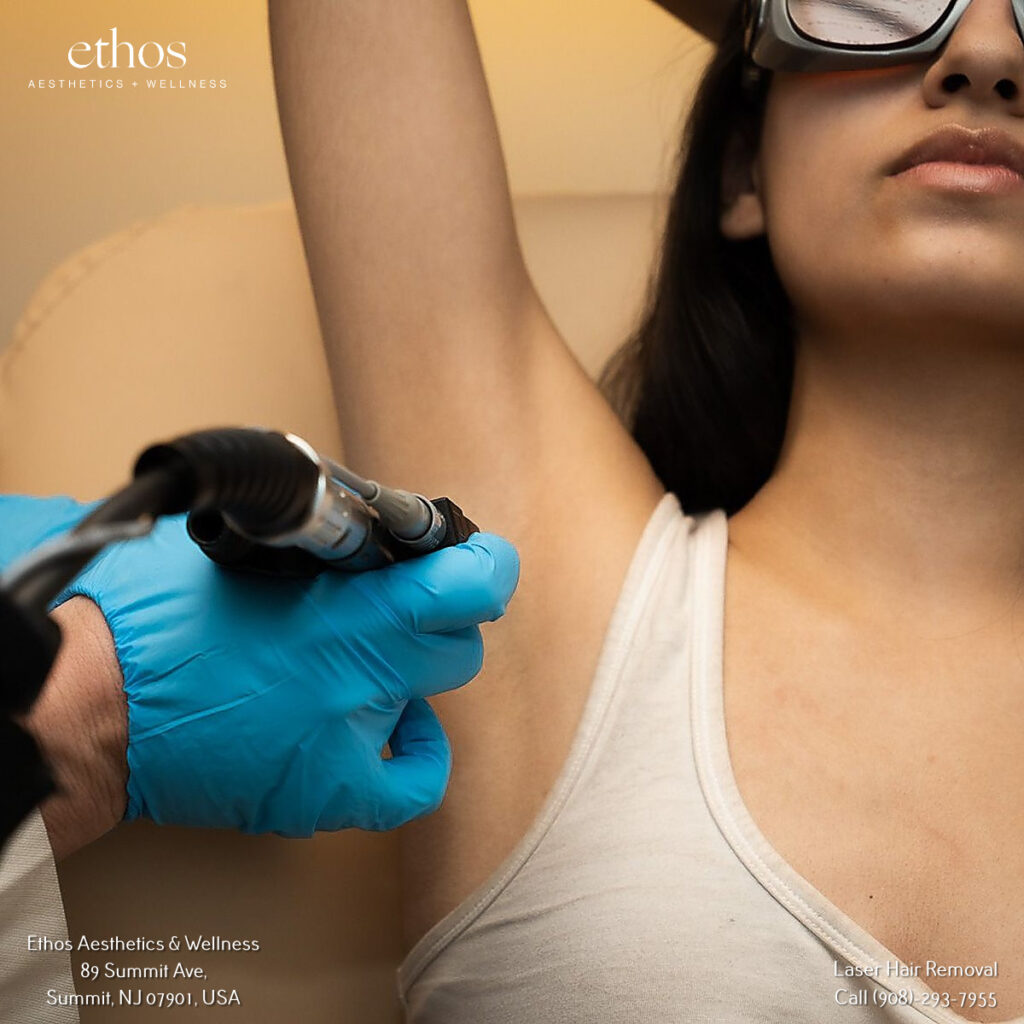If you are reading this, chances are you’ve been contemplating whether to book a laser hair removal session and embark on this journey towards smoother, hair-free skin. However, one question that might be lingering in your mind is, “Does laser hair removal hurt?”
According to market forecasts, the United States is dominating the laser hair removal market significantly, with a whopping 757,808 laser hair removal procedures conducted in 2020. This staggering statistic highlights that despite potential discomfort, an increasing number of individuals are opting for this treatment, demonstrating its enduring popularity in the realm of minimally invasive cosmetic procedures.
But what about the pain levels? Well, many compare the sensation to a rubber band snapping against the skin. However, the experience varies widely depending on individual pain tolerance, skin type, hair type, and the area of the body being treated.
Why People Go For Laser Hair Removal
There are several reasons why laser hair removal has become such a common treatment for removing unwanted hair from the face and body:
- It offers longer lasting hair reduction compared to temporary methods like shaving, waxing, tweezing, and epilating. Most patients see a significant reduction in hair growth after 3-5 treatments.
- Laser hair removal can treat larger areas of unwanted hair growth more efficiently than other hair removal methods. It works well for legs, arms, underarms, bikini line, back, and other areas with extensive hair growth.
- The treatment is generally safe and effective for most skin types, including tanned skin, when performed properly by a trained technician.
- Many seek smoother, hair-free skin in commonly visible areas like the face, underarms, and legs. Laser removes hair more thoroughly and can prevent irritation from shaving and waxing.
- It is a convenient and relatively fast way to treat unwanted hair. Sessions typically last 10-30 minutes depending on the size of the area being treated.
- Laser hair removal results in silky smooth skin and can boost confidence for many people. No more worrying about stubble, shaving rashes, or ingrown hairs.
A Closer Look at How Laser Hair Removal Works
Before we dive into the specifics around pain and side effects, let’s go over the basics of how laser hair removal works.
Laser hair removal utilizes concentrated beams of pulsed light to target and damage the follicles of unwanted hair. The laser beam heats up the pigment in the hair follicle, effectively damaging it so it can no longer grow hair.
Treatments are typically performed in a dermatologist’s office or medspa clinic (like Ethos Spa’s locations in Holmdel, Somerville, Summit, and Sparta Township in New Jersey).
A handheld device is then placed directly on the skin and pulses of laser light are delivered to each area being treated. The treatment can take anywhere from 10 minutes for small areas like the upper lip to over an hour for larger areas like the legs or back.
Multiple treatments are needed to catch all the follicles in the right growth stage. Most people require 4-6 sessions spaced 4-6 weeks apart for optimal results.
Touch up treatments may be required in the future as not every single hair follicle can be permanently disabled.
Now that you understand the basics, let’s take a look at the most common concerns around pain and side effects.
Does Laser Hair Removal Hurt?

The simple answer is yes, most patients do experience some level of pain and discomfort during laser hair removal treatments.
But here’s a surprising statistic: In a study published in the Journal of the American Academy of Dermatology, researchers found that the average pain rating for laser hair removal treatments was 3.09 out of 10, with 10 being the highest level of pain
The idea of laser light zapping hair follicles may sound scary and incredibly painful. But most patients do report that the pain with each individual laser pulse is minor and very tolerable.
The degree of pain usually varies significantly based on:
Individual Pain Tolerance
Everyone has a different threshold for pain. Some people may feel only minimal discomfort during laser hair removal, while others experience more intense pain. Your individual pain tolerance plays a big role.
Location on the Body
Certain parts of the body are more sensitive to pain. Most patients report that the bikini line and upper lip are the most painful locations for laser hair removal. Areas with thinner skin and nerve endings closer to the surface tend to be more sensitive.
Skin Tone
Laser hair removal works by targeting dark pigment in the hair follicles. For effective treatment, there must be a contrast between hair color and skin color. Those with darker skin are at higher risk of pain and skin irritation since the laser settings must be higher to penetrate deeper to the hair follicle.
Type of Laser
Different laser devices use varying wavelengths of light. Some newer hair removal lasers incorporate built-in cooling methods to help make the treatment more comfortable.
Hair Thickness
Coarse, thick hair absorbs more of the laser’s energy, which can lead to more intense pain when treating those hair follicles.
What Causes the Pain During Treatment?
Two primary mechanisms cause pain and discomfort during laser hair removal:
Heat Sensation
As the laser delivers pulses of concentrated light to each hair follicle, heat builds up in the treated areas. The sensation can feel similar to being snapped with a rubber band or receiving tiny hot pinpricks. For some, it feels like prickly heat spreading across the skin’s surface. This heating effect causes most of the pain felt during treatment.
Skin Reaction
The skin may remain red, swollen, and sensitive for a period after laser hair removal sessions. Some patients compare the sensation to a mild sunburn. For darker skin, there is a risk of blistering, crusting, hyperpigmentation, or hypopigmentation. Topical ointments, ice packs, and avoiding sun exposure can help reduce skin reactions and discomfort.
How Bad is the Pain During Laser Hair Removal?
While everyone’s experience varies, most patients report the pain as mild to moderate during laser hair removal treatments:
- The pain only lasts a few seconds per laser pulse. Areas with more hair growth require more pulses, prolonging the discomfort.
- Certain areas like the upper lip, Brazilian bikini line, chest, and underarms tend to be more painful.
- Pain levels usually decrease during the course of multiple treatments as there is less hair to remove.
- Applying numbing cream an hour before the session can significantly reduce discomfort for many patients.
While laser hair removal does cause some level of pain, the treatments are very brief. Most sessions average 15-25 minutes depending on the size of the area being treated. By taking a pain relief medication beforehand and using numbing cream, many patients are able to tolerate the discomfort successfully.
Tips for Minimizing Pain and Discomfort
If you are concerned about painful laser hair removal treatments, here are some tips for making the experience as comfortable as possible:
Numbing Creams
Applying an over-the-counter topical anesthetic cream containing lidocaine for 30-60 minutes prior can numb the skin surface. This offers relief while the laser pulses are delivered. Just be sure to avoid getting the cream into open wounds or mucous membranes.
Pain Medications
Your provider may recommend taking over-the-counter oral pain medications like acetaminophen or anti-inflammatory pills an hour before treatment. This can help reduce sensitivity.
Avoid Caffeine
Caffeine can make the body more sensitive to pain so avoid coffee, tea, soda, and other caffeinated drinks a few hours before the laser session.
Cooling Techniques
Many laser devices have built-in cooling through contact cooling tips, cryogen spray, or air cooling to help make the laser pulses more comfortable.
Comfortable Room Temperature
Having the treatment room set to a comfortable, cool temperature can make the entire experience better.
Music/Videos
Listening to music or watching videos during the session serves as a distraction from any discomfort. The laser technician may be willing to play your playlist.
Laser Settings
Ask your provider to use lower settings on thin and pain-sensitive areas to reduce heat and snapping sensations.
Expert Technician
An experienced laser specialist that you trust can help maximize results while minimizing discomfort. Their technique makes a difference.
Avoid Heat Before Session
Don’t take long hot showers or use saunas right before your laser appointment since heat can intensify sensations.
Laser Hair Removal by the Experts at Ethos Spa

Experience safe, effective laser hair removal from the skilled specialists at Ethos Spa. Our caring team of experts have performed thousands of successful laser hair removal treatments and can help you achieve smooth, stubble-free skin.
Beyond the procedure itself, we provide comprehensive pre- and post-treatment care, guiding you on how to prepare your skin for treatment and manage any potential side effects. With Ethos Spa, you can rest assured knowing you’re in capable and caring hands.
Join the many satisfied clients who have entrusted their laser hair removal to us at Ethos Spa. Get ready to say goodbye to endless shaving and waxing, and hello to smoother, more beautiful skin!







